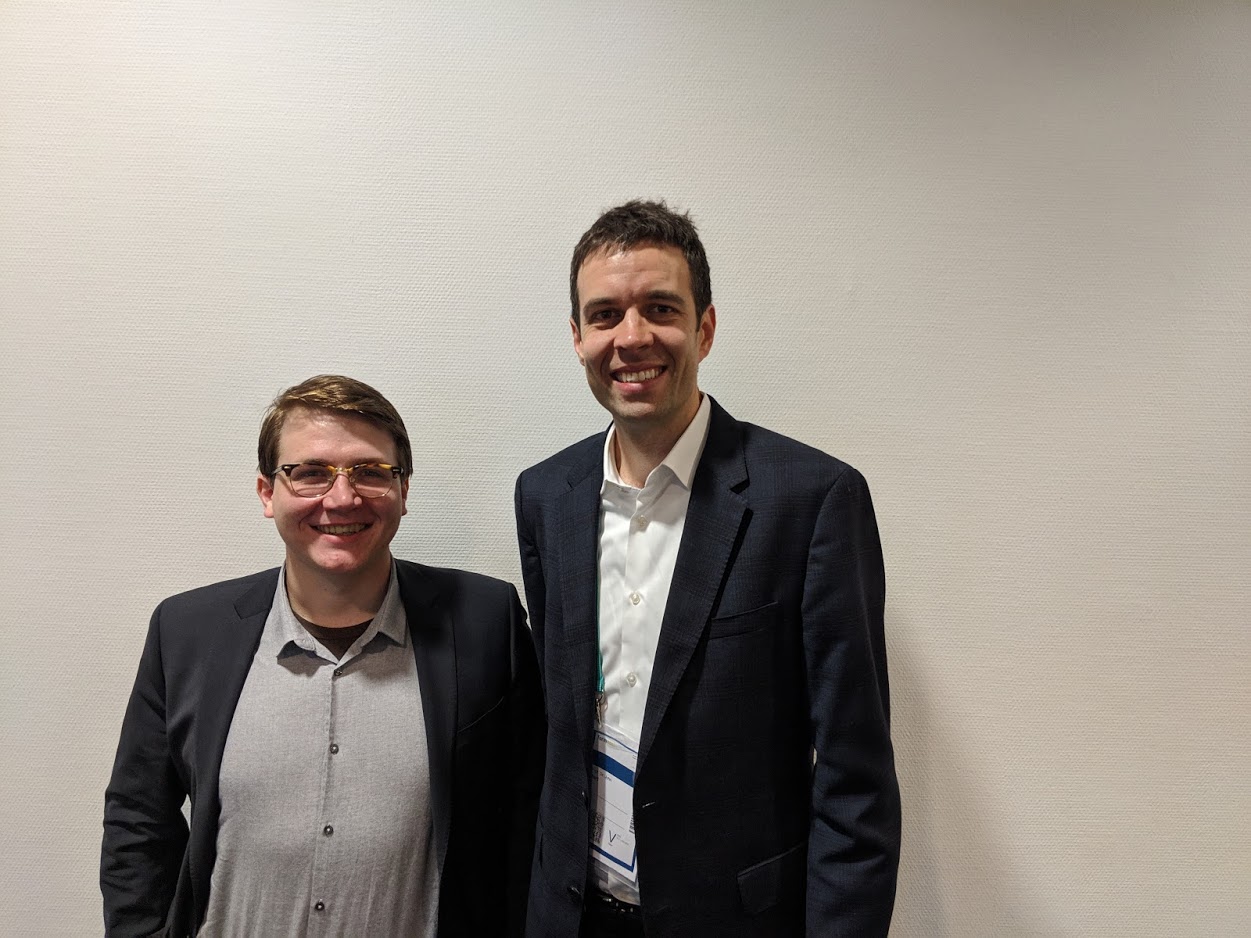![ADAPT Program Manager Haden Quinlan (left) and Founder and Director Professor A. John Hart [Image: Fabbaloo]](https://fabbaloo.com/wp-content/uploads/2020/05/IMG_20181113_110041_img_5eb0a131bdd75.jpg)
A new industry-facing consortium is focused on a collaborative approach to invent the future of additive manufacturing.
The MIT Center for Additive and Digital Advanced Production Technologies (ADAPT) is setting the stage for an ambitious group effort in 3D printing.
Ahead of yesterday’s official launch, I sat down with Professor A. John Hart and Haden Quinlan to chat about what the consortium is setting out to do and the impact they hope to see emerge. Hart is well known for his role leading MIT’s Laboratory for Manufacturing and Productivity as well as research and entrepreneurial endeavors; he’s created and taught 3D printing courses for years, is a co-founder of Desktop Metal, and is the founder and director of the new consortium. He and ADAPT Program Manager Quinlan shared their thoughts about the whats and whys behind the new effort at the recent formnext, where consortium members celebrated the kickoff.
“It’s a good blend. We have heavy influence from automotive, machining, metals, and software,” Quinlan explained of the membership. “At a high level, ADAPT is a multi-partner consortium with a focus on breakthrough research, more so than on applied. We also have the online course, which is running again in February. We’re building that out further, with targeted programs in addition to the overall. This is being put together part on our own, part with our partners.”
Hart added, “We developed the course, and ADAPT will grow into a broader program, ranging from early-stage prototyping through production.”
The focus now, they explained, is on technical understanding first, before moving toward technologies that will be running on a shop floor.
Looking to the defining vision of how industry will evolve, how additive manufacturing combines with digital prototyping — going “a bit beyond what you see” to make actionable decision tools — is a key part of the applied strategy, Hart continued. Building up the business of the industry is necessary as 3D printing continues to progress in capabilities, and ADAPT will use models they build to understand how to further investments.
That MIT is based in Boston is also very helpful, as the area is home to a significant number of well-regarded companies and institutes focusing on advanced technologies.
“There is not at present an agglomerating element in Boston, though it’s one of the most vibrant startup communities. We really want to create a community with global reach, and focus on MIT and Boston. This is a fundamentally multidisciplinary field — hyper-disciplinary, one might say. MIT has the DNA for a wide reach,” Quinlan said.
A benefit of the consortium is that industry partners have access to the brilliant minds at MIT — not just Hart and Quinlan’s, or the other professors involved, but the students who are gearing up to drive the next generations of innovation.
“We’re giving our members access to MIT, including interfacing with the students. We see the impact of additive manufacturing on all fields, and there is a footprint of interest that’s massive in students, with big interest in getting access to that talent pipeline, specific to additive,” Hart added.
The four pillars of ADAPT are:
-
Visionary research
-
Scalable education platforms
-
Actionable strategic insights
-
A vibrant academic-industry ecosystem based at MIT
Bringing these aspects together allows for a forward-facing future for additive and advanced manufacturing. Or, as Quinlan put it, “ADAPT to define the times.”
Founding members of ADAPT adhering to this collaborative, multidisciplinary (or hyper-disciplinary, if you will) consortium include ArcelorMittal, Autodesk, BigRep, Bosch in North America, Dentsply Sirona, EOS, Formlabs, General Motors, Mimaki Engineering Company, Protolabs, Renishaw, and Volkswagen Group.
Vicki Holt, Protolabs’ President and CEO, expresses enthusiasm as a founding member:
“We’ve experienced firsthand the tremendous progress that additive manufacturing has made over the past decade, and we’re quickly approaching another important milestone in 3D printing’s rapid ascent into industrial manufacturing space. My hope is that ADAPT will not only evolve additive manufacturing as a viable digital manufacturing solution for prototyping, but also end-use production. We are thrilled to be a founding member of ADAPT to help make that a reality.”
Protolabs has been focusing on the future of additive manufacturing as a production technology, making the company a good fit for work toward additional innovation and development.
Work at ADAPT begins this month with new exploratory research projects, a new advanced additive manufacturing lab to be established at MIT, and members-only events and symposia to bring the consortium together.
MIT’s educational initiatives will also continue, as Quinlan and Hart noted. These include an online certificate program, Additive Manufacturing for Innovative Design and Production, offered by MITxPRO; and a five-day in-person intensive course called Additive Manufacturing: From 3D Printing to the Factory Floor, offered through MIT Professional Education.
“The in-person program offers specialization, reaching a more diverse audience including in terms of the size of organizations,” Quinlan explained of this course. At $2K/learner, the hands-on coursework ensures that each learner gains direct experience. “There’s no good substitute for seeing, for operating in some instances, the equipment. It’s expanding beyond industry titans.”
Academia and industry working together ensure that work that begins as exploratory and theoretical can progress as appropriate into viable applications ready for real-world implementation. Training for both students and professionals ensures that interested individuals and organizations can gain access to the knowledge they’ll need as additive manufacturing continues to progress as a technology suite for a fast-approaching future.
ADAPT also explains that its myriad activities will enable its members “to implement process, product, and business model innovation and to leverage AM in tandem with the rapidly changing digital manufacturing infrastructure that includes robotics, advanced materials, and computational intelligence.”
Via ADAPT











